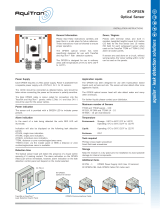Page is loading ...

GENERAL INFORMATION
Please read these instructions carefully and keep them in a safe
place. These instructions must be followed carefully to ensure proper
operation.
The nVent RAYCHEM TraceTek TT-FLAT PROBE has been specifically
designed for use with nVent RAYCHEM TraceTek leak detection
systems. It is designed for use in ordinary areas
with temperatures of 32°F to 122°F (0°C to 50°C).
TOOLS REQUIRED
• Small Phillips head or small flat head screwdriver
• Wire Stripper
INSTALLATION ITEMS (NOT SUPPLIED)
• Jumper cable nVent RAYCHEM TraceTek TT-MJC-1 m/3 ft-PC
740923-000
• End termination nVent RAYCHEM TraceTek TT-MET-PC
169905-000
• Wire loops
• Mounting screws
STORAGE
Keep the TT-FLAT PROBE in a dry place prior to installation. Avoid
damage to components.
PRODUCT CHARACTERISTICS
Dimensions
4.7 in L x 3.8 in W x 1.3 in H (120 mm L x 98 mm W x 32 mm H) nominal
Weight 0.4 lb nominal
Shroud Epoxy coated aluminum, orange
Probes 316 Stainless steel
Probe depth 0.04-0.08 in (1-2mm) nominal
Housing Black ABS plastic, UL 94 HB ammability rating
Maximum ambient temperature 122°F (50°C)
Minimum ambient temperature 32°F (0°C)
Connections 4-wire TraceTek jumper cable to terminal strip
Minimum water depth to trigger leak 0.2 in (5 mm) on metal surface*
Minimum water depth to trigger leak 0.5 in (12.7 mm) on insulating surface*
*With sensor tip height close to mounting surface but not touching
TraceTek TT-FLAT PROBE
Water Leak Detection Probe Installation/Operation Instructions

2 | nVent.com
Installing the TT-FLAT PROBE
Note: To avoid damage to the TT-FLAT PROBE, store the unit
in its packaging until ready to install.
Selecting the mounting location
The TT-FLAT PROBE is for use in ordinary areas. Choose a location
that is expected to accumulate fluid in the event of a water leak,
for example a drip pan or sump.
When mounted on a metal surface (e.g. a drip pan) minimum water
depths of approximately 0.2 in (5 mm) may be required for leak
detection. If the TT-FLAT PROBE is mounted on an insulating surface,
minimum water depths of approximately 0.5 in (12.7 mm) may be
required for leak detection.
Preparing the jumper cable segments for wiring to
the terminal strip
• Cut in half the 3 foot modular jumper cable
(TT-MJC-1M/3ft-PC part # 740923-000).
• The jumper cable segment with the female connector end is
intended for wiring use on the terminal strip labeled OUT.
• The jumper cable segment with the male connector end is intended
for wiring use on the terminal strip labeled IN.
• To prepare the jumper cable segment for wiring use, remove
2 inches of the outer (clear) jacket from the cut end, in order to
provide enough slack for wire connection to the terminal strip.
• Also strip 0.5 in (12.7 mm) of insulation from the end of
each colored wire.
Connecting the TT-FLAT PROBE to TraceTek jumper cable
• Remove the screw that secures the bottom cover of the unit
(see Figure 1). Set cover aside, being careful not to lose the screw.
Loose plastic tie wraps may be found inside the unit, set them
aside for later use to provide strain relief on cable wiring.
Single end of line probe wiring connections
• If the TT-FLAT PROBE is being used as a single probe
(or as the last component of a larger chain), refer to Figure 2A
for guidance in making proper wiring connections.
• Connect the colored wires in the jumper cable segment with the
male connector end per the Yellow (Y), Black (B), Red (R ), Green (G)
markings next to the terminal strip labeled IN.
• Push the lever lock to open the terminal strip and insert the wire
end completely until it stops, then release the lever lock.
• Gently pull each wire to verify it is captured by the lever lock.
• Verify the wire connection quality by checking continuity.
• Create two wire loops, and install them on the terminal strip labeled
OUT per the Illustration. One loop connects Yellow (Y) and
Black (B), the other Red (R) and Green (G).
Note: Instead of using two wire loops, a segment of modular
jumper cable and an end termination (TT-MET-PC) can be used as
an alternative wiring connection to the terminal strip labeled OUT.
See Figure 2B. This installation method allows for future extension
of the system.
The modular jumper cable is connected to the terminal strip labeled
OUT position as shown in Figure 3.
Push the lever lock to open the terminal strip and insert the wire
end completely until it stops, then release the lever lock. Gently pull
each wire to verify it is captured by the lever lock. Verify the wire
connection quality by checking continuity.
Figure 1. Removing the screw that secures the bottom cover of
the unit
Figure 2A. Single probe wiring conguration with wire loops on
terminal strip labeled OUT
End termination (TT-MET-PC)
Remove for future extension
© 2014 nVent LLC
NVENT.COM
H58464 09/14
Figure 2B. Single probe wiring conguration if using jumper cable
and an end termination

nVent.com | 3
Multiple probe wiring connections
• Refer to the Figure 3 for the wiring connections associated with use
of the TT-FLAT PROBE in a chain of TraceTek leak detection cable
or other TT-FLAT PROBE.
• Connect the colored wires in the jumper cable segment with the
male connector end per the Yellow (Y), Black (B), Red (R), Green (G)
markings next to the terminal strip labeled IN.
• Push the lever lock to open the terminal strip and insert the wire
end completely until it stops, then release the lever lock.
• Gently pull each wire to verify it is captured by the lever lock.
• Verify the wire connection quality by checking continuity.
• For the next component in the chain (either another TT-FLAT
PROBE or TraceTek leak detection cable) connect the colored wires
in the jumper cable segment with the female end connector to the
terminal strip labeled OUT.
• Connect the colored wires in the jumper cable segment per the
Yellow (Y), Black (B), Red (R), Green (G) terminal strip markings.
• Push the lever lock to open the terminal strip and insert the wire
end completely until it stops, then release the lever lock.
• Gently pull each wire to verify it is captured by the lever lock.
• Verify the wire connection quality by checking continuity.
Applying strain relief
Attach the provided plastic tie wrap to any connected jumper cable
very close to interior side of the black wall of the unit. See the arrow
on Figure 3 as a guideline for where to apply the tie wrap. Be sure to
cut off excess portions of the tie wrap once secured to the cable, so
that the rear cover can easily be reinstalled.
Putting the rear cover back on the TT-FLAT PROBE
Carefully position the rear cover with the screw hole properly aligned
over the TT-FLAT PROBE body. Gently install the screw and tighten the
screw to secure the bottom cover.
Mounting the TT-FLAT PROBE in position
The orange frame has been constructed with holes on each side to
allow bolts or screws to secure the unit to the mounting surface.
Alternately, adhesive could be used to secure the frame to the
mounting surface.
If appropriate, the TT-FLAT PROBE can rest loosely on the mounting
surface.
Verify prior to mounting the unit that the probe tips are at desired
height above the floor surface.
Mapping point identified
It is recommended to characterize the mapping point information for
the TT-FLAT PROBE. With the nVent RAYCHEM TraceTek TTDM-128
master module powered on and all TraceTek cabling connected to
the TT-FLAT PROBE, temporarily short the two metal probes on the
TT-FLAT PROBE (for example, with a screwdriver). Be sure to maintain
this temporary short for 20 seconds, which is long enough for the
TTDM-128 master module to identify the leak location length. Write
this length on the TT-FLAT PROBE label in the white mapping point
area for future reference.
Figure 3. Multiple probe wiring conguration and suggested tie
wrap location

©2019 nVent. All nVent marks and logos are owned or licensed by nVent Services GmbH or its aliates. All other trademarks are the property of their respective owners.
nVent reserves the right to change specications without notice.
RAYCHEMTraceTek-IM-H58463-TTFLATprobe-EN-1907
nVent.com
North America
Tel +1.800.545.6258
Fax +1.800.527.5703
Europe, Middle East, Africa
Tel +32.16.213.511
Fax +32.16.213.604
Asia Pacific
Tel +86.21.2412.1688
Fax +86.21.5426.3167
Latin America
Tel +1.713.868.4800
Fax +1.713.868.2333
Maintenance and Troubleshooting
Leak detection indication information
• When the TT-FLAT PROBE is utilized as part of a TraceTek leak detection system, it will typically be monitored by a TTDM-128 master module.
• The TT-FLAT PROBE is built with terminal strips and uses resistors to simulate a length of TraceTek cable. These resistors produce a cable length
equivalent to 25 ft (8 m) for the rst TT-FLAT PROBE, and 50 ft (16 m) for each subsequent TT-FLAT PROBE.
• If TT-FLAT PROBEs are used alone (without TraceTek sensing cable) in a leak detection circuit, the "Zones" setting can be used on the TTDM-128
master module.
/



